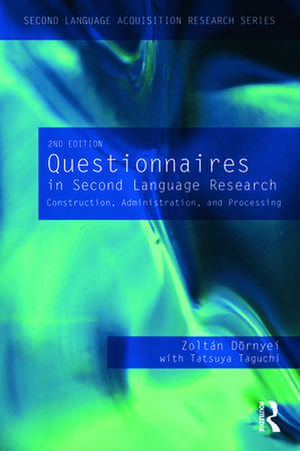Questionnaires in Second Language Research
Autor Zoltán Dörnyei, Tatsuya Taguchien Limba Engleză Paperback – 31 ian 2010
Preț: 362.50 lei
Nou
Puncte Express: 544
Preț estimativ în valută:
69.37€ • 72.76$ • 57.74£
69.37€ • 72.76$ • 57.74£
Carte indisponibilă temporar
Doresc să fiu notificat când acest titlu va fi disponibil:
Se trimite...
Preluare comenzi: 021 569.72.76
Specificații
ISBN-13: 9780415998208
ISBN-10: 0415998204
Pagini: 185
Dimensiuni: 152 x 226 x 10 mm
Greutate: 0.3 kg
Ediția:Revizuită
Editura: Taylor & Francis
Locul publicării:United Kingdom
ISBN-10: 0415998204
Pagini: 185
Dimensiuni: 152 x 226 x 10 mm
Greutate: 0.3 kg
Ediția:Revizuită
Editura: Taylor & Francis
Locul publicării:United Kingdom
Cuprins
Introduction
1. Questionnaires in Second Language Research
1.1 What are ‘questionnaires’ and what do they measure?
1.2 Why use questionnaires and why not?
1.3 Questionnaires in quantitative and qualitative research
2. Constructing the Questionnaire
2.1 General features
2.2 The main parts of a questionnaire
2.3 Appropriate sampling of the questionnaire content and the significance of ‘multi-item scales’
2.4 ‘Closed-ended’ questionnaire items
2.5 Open-ended questions
2.6 How to write good items
2.7 Grouping and sequencing items
2.8 Translating the questionnaire
2.9 Computer programs for constructing questionnaires
2.10 Piloting the questionnaire and conducting item analysis
3. Administering the Questionnaire
3.1 Selecting the sample
3.2 Main types of questionnaire administration
3.3 Strategies to increase the quality and quantity of participant response
3.4 Questionnaire administration, confidentiality, and other ethical issues
4. Processing Questionnaire Data
4.1 Coding questionnaire data
4.2 Inputting the data
4.3 Processing closed questions
4.4 Content analysis of open-ended questions
4.5 Computer programs for processing questionnaire data
4.6 Summarizing and reporting questionnaire data
4.7 Complementing questionnaire data with other information
5. Illustration: Developing a Motivation Questionnaire
5.1 Construction of the initial questionnaire
5.2 Translating and initial piloting
5.3 Final piloting and item analysis
5.4 The final version of the Japanese questionnaire and post hoc item analysis
5.5 Adapting the questionnaire for use in China and Iran
Conclusion and Checklist
References
Appendix A: Combined List of the Items Included in the Questionnaires Discussed in Chapter 5
Appendix B: The Final Version of the Questionnaires Used in Japan, China and Iran
Appendix C: Selected List of Published L2 Questionnaires
1. Questionnaires in Second Language Research
1.1 What are ‘questionnaires’ and what do they measure?
1.2 Why use questionnaires and why not?
1.3 Questionnaires in quantitative and qualitative research
2. Constructing the Questionnaire
2.1 General features
2.2 The main parts of a questionnaire
2.3 Appropriate sampling of the questionnaire content and the significance of ‘multi-item scales’
2.4 ‘Closed-ended’ questionnaire items
2.5 Open-ended questions
2.6 How to write good items
2.7 Grouping and sequencing items
2.8 Translating the questionnaire
2.9 Computer programs for constructing questionnaires
2.10 Piloting the questionnaire and conducting item analysis
3. Administering the Questionnaire
3.1 Selecting the sample
3.2 Main types of questionnaire administration
3.3 Strategies to increase the quality and quantity of participant response
3.4 Questionnaire administration, confidentiality, and other ethical issues
4. Processing Questionnaire Data
4.1 Coding questionnaire data
4.2 Inputting the data
4.3 Processing closed questions
4.4 Content analysis of open-ended questions
4.5 Computer programs for processing questionnaire data
4.6 Summarizing and reporting questionnaire data
4.7 Complementing questionnaire data with other information
5. Illustration: Developing a Motivation Questionnaire
5.1 Construction of the initial questionnaire
5.2 Translating and initial piloting
5.3 Final piloting and item analysis
5.4 The final version of the Japanese questionnaire and post hoc item analysis
5.5 Adapting the questionnaire for use in China and Iran
Conclusion and Checklist
References
Appendix A: Combined List of the Items Included in the Questionnaires Discussed in Chapter 5
Appendix B: The Final Version of the Questionnaires Used in Japan, China and Iran
Appendix C: Selected List of Published L2 Questionnaires
Recenzii
"An expert in questionnaire-based research, Dornyei has produced an informative, fully updated, very accessible, and highly practical treatment of questionnaires in second language research. Through its balanced presentation of theoretical principles and sage advice as well as concrete examples of questionnaire design, administration, and analysis, the book offers applied linguists a wonderful resource with wide applicability."
-Patricia A. Duff, University of British Columbia, Canada
"This is an outstanding ‘how to’ resource book for L2 researchers and their students. It will be useful to all who use questionnaires, whether regularly or only on occasion. It is written in an exceptionally clear and accessible style. This Second Edition contains welcome new material—a step-by-step examination of a case study, detailed discussion of how to handle translation, and information on internet-based questionnaires. Altogether, very highly recommended!"
-Norman Segalowitz, Concordia University, Canada
-Patricia A. Duff, University of British Columbia, Canada
"This is an outstanding ‘how to’ resource book for L2 researchers and their students. It will be useful to all who use questionnaires, whether regularly or only on occasion. It is written in an exceptionally clear and accessible style. This Second Edition contains welcome new material—a step-by-step examination of a case study, detailed discussion of how to handle translation, and information on internet-based questionnaires. Altogether, very highly recommended!"
-Norman Segalowitz, Concordia University, Canada
Notă biografică
Zoltán Dörnyei is Professor of Psycholinguistics in the School of English Studies at the University of Nottingham, UK.
Tatsuya Taguchi is a PhD candidate in the School of English Studies at the University of Nottingham, UK.
Tatsuya Taguchi is a PhD candidate in the School of English Studies at the University of Nottingham, UK.
